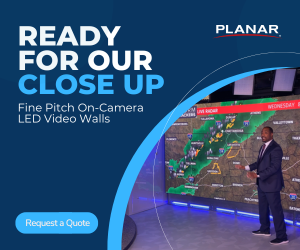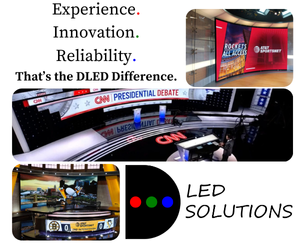Industry Insights: Navigating cost, creativity and complexity in virtual sets

Subscribe to NCS for the latest news, project case studies and product announcements in broadcast technology, creative design and engineering delivered to your inbox.
Virtual production has rapidly evolved from a buzzword to a core strategy. In this second installment of our Industry Insights series on graphics and virtual workflows, we examine how broadcasters are applying these tools across news, sports and studio operations.
From cost efficiency to creative flexibility, virtual sets and augmented environments are no longer limited to special events – they’re reshaping everyday production.
This roundtable explores the balance between green screens and LED volumes, the realities of technical integration and how trends from Hollywood are influencing live broadcast. With the technology now more accessible and scalable, the conversation shifts from how virtual production gets deployed to what opportunities come with it.
Key takeaways from this Industry Insights roundtable
- Gradual implementation trend: Broadcasters are layering in virtual tools step by step, often starting with news and sports before scaling up.
- Set design reimagined: Virtual sets allow for more shows, faster changes, and reduced physical construction costs.
- Creative and technical balance: Success depends on high-fidelity tracking, GPU power, and seamless alignment with existing workflows.
- Remote and flexible production: Virtual tools are reducing the need for travel and OB trucks, supporting more sustainable operations.
- Hollywood influence rising: As compositing and rendering quality improve, viewer expectations for realism in broadcast content are climbing.
Virtual production was a buzzword a few years ago. Where are we today on usage and implementation in broadcast?
Mathieu Mazerolle, director of product, new technology, Foundry: Virtual production has evolved in meaning over time. In film, it originally referred to the pre-visualization techniques James Cameron used making “Avatar.” A few years ago, the term got rebranded around game engines and LED volumes for film and TV. Today, it describes a broader set of techniques that blend photographic and virtual imagery in real time. In that sense, broadcast has actually been a pioneer in virtual production for decades. What’s new is how Hollywood is using the technique to push the boundaries of quality and realism with large-scale in-camera VFX. I fully expect broadcasters to increasingly harness these capabilities to enhance the program quality—which is one reason Foundry is investing in the space.
Onur Can Gulenc, sales manager, Zero Density: On the global scale, the US is catching up to its European counterparts. The adoption will continue to increase as emerging technologies like generative AI assist in content generation, keying and masking, making a lot of big-budget, time-consuming items in the past more accessible. This allows for small and medium-scale channels to utilize it more easily since existing graphics production skills can be enough instead of establishing a large team with varied specialties.
Miguel Churruca, marketing and communications director, Brainstorm: Virtual production is becoming a widely used technology, and broadcasters now realize that its benefits go far beyond the ability to create scenes that do not exist. In broadcast, the reduction of props and set construction, and the optimization of real estate is a significant benefit for televisions. What customers ask for is hyperrealism, and of course, flexibility for creating different content for a variety of applications. This means that the tools must ensure not only a perfectly realistic background scene, but also the ability to include data-driven graphics, control of other hardware such as studio lights, and the compatibility with broadcast workflows.
Steve Taylor, chief product and technology officer, Vizrt: There’s an interesting division between customers where some really like to go sort of broadcasting from a room covered with green screen and using our tech exclusively, and others still prefer physical screens and LEDs and relying on real environments. And it is quite interesting to see how that’s evolving. I don’t see any clear winner at the moment, which is kind of good for both sides. And then we’re trying to sort of break through that by removing the green screen so I can do the same thing in any environment.
What specific benefits do broadcasters see from adopting virtual production methods?
Mathieu Mazerolle, director of product, new technology, Foundry: Much like in Hollywood, broadcasters are using virtual production to elevate the visual experience and spark the viewer’s imagination. It enables audiences to be transported anywhere, at any time. Broadcasting was ahead of its time in many respects — going all the way back to early prototypes of the 1st & Ten graphics system in the late 1970s. But there’s still a lot of untapped potential, especially in how virtual production can enhance real-time immersion and support individualized or targeted content delivery.
Onur Can Gulenc, sales manager, Zero Density: Virtual production offers a long list of benefits to broadcasters like reliability, efficiency, integration, enhanced storytelling and visual impact. Reliability through proven platforms, boosted efficiency with using the same graphic across different applications, seamless integration of real-time data and virtual elements for the live broadcasts are just a few. Consequently, virtual studio production significantly enhances storytelling capabilities by creating dynamic, immersive environments and delivers unparalleled visual impact that captivates audiences.
Mike Paquin, senior product manager, virtual solutions, Ross Video: Virtual production offers broadcasters tremendous flexibility, enabling them to create and switch between immersive environments quickly and cost-effectively. This approach allows for deeper storytelling, as sets and props can be tailored to different branding and platforms without the constraints of physical storage or construction. Ultimately, it brings more vibrancy and variety to broadcast content.
Steve Taylor, chief product and technology officer, Vizrt: Everybody that’s actually physically involved in doing events would much rather be doing this from home or local rather than jumping on a plane and then sitting in an OB van. So it’s an interesting turning point. We’ve got through to the point where you don’t need to talk about cloud anymore. It’s just why aren’t you using those computers or that system rather than the one that’s in your warehouse or OB van.
How are broadcasters approaching virtual production?
Mathieu Mazerolle, director of product, new technology, Foundry: Most are layering it in gradually — adding virtual sets to newsrooms or experimenting with augmented reality for live sports. Some are collaborating with third-party studios that bring deep real-time production expertise, while others are building in-house teams, often recruiting from VFX or gaming. What’s exciting is that viewer expectations around visual quality are only going up. Today’s on-air graphics will start to feel dated as Hollywood-level compositing becomes possible in a live feed with tools like Nuke Stage.
Onur Can Gulenc, sales manager, Zero Density: The general assumption of broadcasters towards virtual production is that it is more suitable for special projects. However, in the last several years, we have seen our technology being utilized day-to-day and 24/7 broadcasting in certain seasons.
Miguel Churruca, marketing and communications director, Brainstorm: Broadcasters often start using virtual technology for storytelling purposes, to enhance the looks of their news and sports operations, but quickly understand that the benefits of virtual production go far beyond. I mentioned the reduction of the real state required for broadcast operations, or the flexibility of creating immersive shows, but in a cost-driven operation with increasingly constrained budgets, technologies that help with reducing operation costs, space requirements, construction or that improve the overall sustainability of the channel, are worth looking at. Moreover, when virtual production technology is becoming more accessible for broadcasters and productions of any size, the co-existence of virtual and real technologies is increasingly common.
Steve Taylor, chief product and technology officer, Vizrt: There’s an interesting division between customers where some really like to go sort of broadcasting from a room covered with green screen and using our tech exclusively, and others still prefer physical screens and LEDs and relying on real environments. And it is quite interesting to see how that’s evolving. I don’t see any clear winner at the moment, which is kind of good for both sides.
How is sports production, specifically, embracing virtual production?
Mathieu Mazerolle, director of product, new technology, Foundry: Sports is one of the fastest-moving areas for VP. We’re seeing virtual desks, immersive pre-game studios, and AR graphics that respond to live tracking data. But it’s more than just eye candy — it’s about drawing viewers deeper into the action. There’s growing demand for tools that can handle complex compositing in a live pipeline, blending real-time and post-production techniques. That intersection is exactly what we’re exploring with Nuke Stage, building on Foundry’s deep experience in seamlessly combining photographic and virtual content.
Steve Taylor, chief product and technology officer, Vizrt: We’ve done a lot of proof of concepts and we’ve seen some really big broadcasters — NHL a couple of years back and some other big sports events exclusively live. I think the pre-show to the Super Bowl was done by Fox with virtual tech as well. And I think this is really reassuring, but the question is why isn’t everybody doing it? Why are people still holding on to their data centers and their hardware? And the key question is, have we not found the right parameter to turn here?
How are virtual sets affecting budget considerations for broadcast studios?
Marcus B. Brodersen, CEO, Pixotope: Virtual sets aren’t just a budget line — they replace set construction, storage, lighting rigs, and traditional graphics with a unified, scalable solution. Treating them as “fancy graphics” misses the point: since they merge scenic, lighting, and design workflows, virtual sets require proper time and resources upfront to deliver 10x the creative options at a fraction of the ongoing cost. Smart studios are reallocating their entire physical production budgets to virtual, because they are discovering they can produce five different shows where they once built one set – making virtual sets not an expense, but a multiplier.
Mathieu Mazerolle, director of product, new technology, Foundry: There’s an upfront investment — tracking systems, LED walls, and playback infrastructure — but over time, the cost structure levels out. Digital assets can be reused and scaled across multiple shows or events. More importantly, virtual production opens the door to creative possibilities that would otherwise be cost-prohibitive. I’d also encourage broadcasters to plan ahead for where the tech is heading. Standards like SMPTE 2110 are still maturing, but they are worth considering now to avoid costly rework down the line.
Onur Can Gulenc, sales manager, Zero Density: There is an upfront cost for the broadcasters, but in the long term, the benefits significantly outpace the investment as the number of efficient projects and designed programs increases. Since virtual studios eliminate the need for separate physical sets, they reduce material waste, save time and enhance productivity with increased studio utilization as well.
Miguel Churruca, marketing and communications director, Brainstorm: The democratization of the virtual production is also the result of a wider and, in some cases, more affordable range of solutions to choose from, and when budget is less of an excuse for excellent results, creator’s creativity is even more important to make a difference. Add the cost reductions we’ve mentioned before, and virtual sets are a no-brainer for many operations. The possibility of reusing a small set for several productions at the same time by using different virtual set and minimal props is a compelling argument in favor of this technology, especially when hyperrealistic virtual sets are accessible for all kind of content creators. This does not mean virtual production is a replacement for real production in all cases, but certainly an alternative to consider when designing broadcast operations.
What technical considerations are key when integrating virtual into existing workflows?
Marcus B. Brodersen, CEO, Pixotope: Successful virtual production integration requires precision camera tracking, significant GPU rendering power, and expanded infrastructure — but these aren’t dealbreakers when properly planned for. The key is ensuring your new virtual systems can route through existing graphics pipelines and broadcast infrastructure, maintaining the flexibility crews already rely on. Long-term success depends on choosing the right approach for your needs: LED walls demand meticulous tracking maintenance, while green screen workflows offer more forgiving tolerances — either way, factor in dedicated technical resources from day one.
Mathieu Mazerolle, director of product, new technology, Foundry: Camera tracking, latency, and color fidelity are always top priorities. If virtual elements aren’t precisely aligned or don’t match the look of the live feed, the illusion breaks. Broadcast environments also demand rock-solid reliability and fast turnaround, so integration and redundancy are essential. A big focus with Nuke Stage is delivering the same level of image quality and creative control expected by Hollywood directors — while ensuring that it fits into the speed and resilience required for live broadcast pipelines.
Mike Paquin, senior product manager, virtual solutions, Ross Video: There is still some resistance to virtual solutions due to past experiences with less reliable solutions, but tracking technology has improved a lot in the last few years. Reliable tracking technology is essential for the seamless integration of virtual elements for augmented reality, and recent advancements have made these systems more precise and user-friendly. The introduction of trackless virtual applications has helped introduce a whole new way to produce virtual content without the added technology. One thing we focus on at Ross is ensuring any new virtual tools complement existing workflows rather than complicate them, which is crucial for successful adoption.
Subscribe to NCS for the latest news, project case studies and product announcements in broadcast technology, creative design and engineering delivered to your inbox.






tags
Brainstorm 3D, Brainstorm Multimedia, Foundry, Marcus Brodersen, Mathieu Mazerolle, Miguel Churruca, Mike Paquin, Onur Can Gulenc, Pixotope, Ross Video, Steve Taylor, Virtual Production, Virtual Sets, virtual studios, Vizrt, Zero Density
categories
Augmented Reality, Virtual Production and Virtual Sets, Featured, Industry Insights, Virtual Sets, Voices